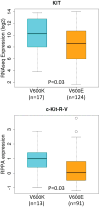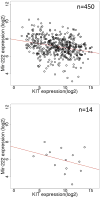Putative genomic characteristics of BRAF V600K versus V600E cutaneous melanoma
- PMID: 28858076
- PMCID: PMC5669042
- DOI: 10.1097/CMR.0000000000000388
Putative genomic characteristics of BRAF V600K versus V600E cutaneous melanoma
Abstract
Approximately 50% of all cutaneous melanomas harbor activating BRAF V600 mutations; among, these 10-30% carry the V600K mutation. Clinically, patients with V600K tumors experience distant metastases sooner and have an increased risk of relapse and shorter survival than patients with V600E tumors. Despite the clinical and other histopathological differences between these BRAF tumor subtypes, little is known about them at the genomic level. Herein, we systematically compared BRAF V600E and V600K skin cutaneous melanoma (SKCM) samples from the Cancer Genome Atlas (TCGA) for differential protein, gene, and microRNA expression genome-wide using the Mann-Whitney U-test. Our analyses showed that elements of energy-metabolism and protein-translation pathways were upregulated and that proapoptotic pathways were downregulated in V600K tumors compared with V600E tumors. We found that c-Kit protein and KIT gene expressions were significantly higher in V600K tumors than in V600E tumors, concurrent with significant downregulation of several KIT-targeting microRNAs (mir) including mir-222 in V600K tumors, suggesting KIT and mir-222 might be key genomic contributors toward the clinical differences observed. The relationship that we uncovered among KIT/c-Kit expression, mir-222 expression, and growth and prosurvival signals in V600 tumors is intriguing. We believe that the observed clinical aggressiveness of V600K tumors compared to V600E tumors may be attributable to the increased energy metabolism, protein translation and prosurvival signals compared with V600E tumors. If confirmed using larger numbers of V600K tumors, our results may prove useful for designing clinical management and targeted chemotherapeutical interventions for BRAF V600K-positive melanomas. Finally, the small sample size in V600K tumors is a major limitation of our study.
Conflict of interest statement
Figures






Comment in
-
Characteristics of BRAF V600K versus V600E: Effect of molecular weight change in melanoma.J Cancer Res Ther. 2021 Jan-Mar;17(1):291. doi: 10.4103/jcrt.JCRT_433_18. J Cancer Res Ther. 2021. PMID: 33723174 No abstract available.
Similar articles
-
Spectrum and Frequency of BRAF Mutations in Skin Melanomas in the Dalmatian Region of Croatia.Acta Dermatovenerol Croat. 2024 Mar;32(1):75-76. Acta Dermatovenerol Croat. 2024. PMID: 38946192
-
Distinct Molecular Profiles and Immunotherapy Treatment Outcomes of V600E and V600K BRAF-Mutant Melanoma.Clin Cancer Res. 2019 Feb 15;25(4):1272-1279. doi: 10.1158/1078-0432.CCR-18-1680. Epub 2019 Jan 10. Clin Cancer Res. 2019. PMID: 30630828 Free PMC article.
-
BRAF-V600 Mutation Heterogeneity in Primary and Metastatic Melanoma: A Study With Pyrosequencing and Immunohistochemistry.Am J Dermatopathol. 2016 Feb;38(2):113-20. doi: 10.1097/DAD.0000000000000404. Am J Dermatopathol. 2016. PMID: 26630683
-
Braf-Mutant Melanomas: Biology and Therapy.Curr Oncol. 2024 Dec 3;31(12):7711-7737. doi: 10.3390/curroncol31120568. Curr Oncol. 2024. PMID: 39727691 Free PMC article. Review.
-
BRAF V600E mutation-specific antibody: A review.Semin Diagn Pathol. 2015 Sep;32(5):400-8. doi: 10.1053/j.semdp.2015.02.010. Epub 2015 Feb 7. Semin Diagn Pathol. 2015. PMID: 25744437 Review.
Cited by
-
Optimal treatment strategy for metastatic melanoma patients harboring BRAF-V600 mutations.Ther Adv Med Oncol. 2020 Jun 19;12:1758835920925219. doi: 10.1177/1758835920925219. eCollection 2020. Ther Adv Med Oncol. 2020. PMID: 32612709 Free PMC article. Review.
-
The impact of current treatment modalities on the outcomes of patients with melanoma brain metastases: A systematic review.Int J Cancer. 2020 Mar 15;146(6):1479-1489. doi: 10.1002/ijc.32696. Epub 2019 Nov 23. Int J Cancer. 2020. PMID: 31583684 Free PMC article.
-
Increased Expression of T-Box Transcription Factor Protein 21 (TBX21) in Skin Cutaneous Melanoma Predicts Better Prognosis: A Study Based on The Cancer Genome Atlas (TCGA) and Genotype-Tissue Expression (GTEx) Databases.Med Sci Monit. 2020 Jun 20;26:e923087. doi: 10.12659/MSM.923087. Med Sci Monit. 2020. PMID: 32561704 Free PMC article.
-
Current Controversies and Challenges on BRAF V600K-Mutant Cutaneous Melanoma.J Clin Med. 2022 Feb 4;11(3):828. doi: 10.3390/jcm11030828. J Clin Med. 2022. PMID: 35160279 Free PMC article. Review.
-
Interacting Genetic Lesions of Melanoma in the Tumor Microenvironment: Defining a Viable Therapy.Adv Exp Med Biol. 2021;1350:123-143. doi: 10.1007/978-3-030-83282-7_6. Adv Exp Med Biol. 2021. PMID: 34888847
References
-
- Wan PT, Garnett MJ, Roe SM, Lee S, Niculescu-Duvaz D, Good VM, Jones CM, Marshall CJ, Springer CJ, Barford D, et al. Mechanism of activation of the RAF-ERK signaling pathway by oncogenic mutations of B-RAF. Cell. 2004;116(6):855–867. - PubMed
-
- Stadelmeyer E, Heitzer E, Resel M, Cerroni L, Wolf P, Dandachi N. The BRAF V600K mutation is more frequent than the BRAF V600E mutation in melanoma in situ of lentigo maligna type. J Invest Dermatol. 2014;134(2):548–550. - PubMed
-
- Bucheit AD, Syklawer E, Jakob JA, Bassett RL, Jr, Curry JL, Gershenwald JE, Kim KB, Hwu P, Lazar AJ, Davies MA. Clinical characteristics and outcomes with specific BRAF and NRAS mutations in patients with metastatic melanoma. Cancer. 2013;119(21):3821–3829. - PubMed
-
- Menzies AM, Haydu LE, Visintin L, Carlino MS, Howle JR, Thompson JF, Kefford RF, Scolyer RA, Long GV. Distinguishing clinicopathologic features of patients with V600E and V600K BRAF-mutant metastatic melanoma. Clin Cancer Res. 2012;18(12):3242–3249. - PubMed
Publication types
MeSH terms
Substances
Grants and funding
LinkOut - more resources
Full Text Sources
Other Literature Sources
Medical
Research Materials

